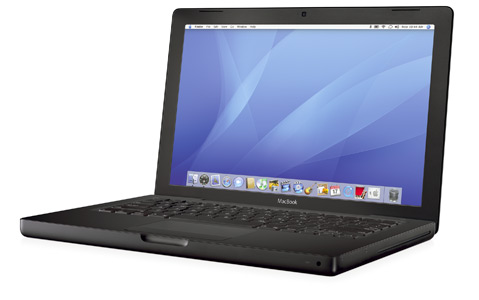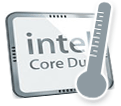|
This site will help collect and show the temperatures of Apple Macintosh computers using the new processors by Intel. All new computers that haven't faced the trail of time
will have problems and issues that can make users mad and furious. As with the new MacBook Pro machines where were, and still are, problems with heat dissipation. After scouting
forums and help sites for information about what temperatures I can expect on a new MacBook, but that turned out to be harder and more scattered than I first imagined. That's the main
motive behind this site and it didn't take too long to setup as I had the base code handy from another site.
-
Machine profile
|
| Added by: |
mattbr, 2006-05-31 |
| Introduction date: |
Mid-2006 model (2006-05-16) |
| SKU/order number: |
MA472LL/A |
| Base model: |
Apple MacBook 13-inch 2.0 GHz Black |
| Serial number: |
4H620XXXXXX |
| Manufacturing info: |
Assembled: May, 2006, Week 20
Plant: China |
| Whine issue / Moo issue: |
Unknown / Yes |
|
| CPU frequency: |
2.00 GHz |
| Memory: |
512 MB |
| Storage drive: |
Seagate 80 GB 5400 RPM |
| OS version: |
Mac OS X 10.4.6 |
| Boot ROM version: |
N/A |
| SMC system version: |
N/A |
|
|
| Ambient/room temperature: |
18 °C |
| Recorded temperatures on stock cooling: |
| Idle (<5%) temperature: |
53 °C |
| Load (100%) temperature: |
90 °C |
| Drive temperature: |
0 °C |
|
| video of a load experiment (iddle => dnet client => iddle) up at http://www.youtube.com/watch?v=teCiJFkrrZc |
| [Report this entry - Edit entry] |
|
Comments
| #1 - posted by
(212.48.4.*) | 2012-04-07 18:56:29 |
| I have owned many Apple laptops and cmuopters over the years, and without a doubt think that the 2010 13 Macbook Air is one of the strongest offerings the company has ever had. I am a power user' and use my laptop for heavy photo and video editing. I frequently have Photoshop running simultaneously with many other memory-intensive programs, including Windows 7 (through Parallels), and use my laptop for hours every day. I purchased the 13 Macbook Air (which I'll refer to as MBA' for simplicity) directly from Apple, and added 2GB of RAM to make the set-up 4GB total. I do not know if Amazon allows you to customize it this way, so if it doesn't consider buying it directly from Apple or another store which does allow this upgrade. From what I understood, due to the MBA's construction the RAM is soldered onto the motherboard you won't be able to add RAM yourself later. If you're a light user, you should probably be fine with just 2 GB of RAM, but if you plan to intensively multi-task, consider upgrading the RAM. This laptop is expensive, but is worth every penny if you can afford it. While it lacks an optical drive and certain ports which can at times be inconvenient it makes up for that by offering great performance and a stunning design. DESIGN I thought my 2010 13 Macbook Pro (which I'll refer to as MBP') was sleek and stylish, but this is just amazing. The MBP looks sleeker in some ways since its keyboard is backlit and its display has a nicer black trim to it, but in overall design, the MBA just can't be beat. You won't truly appreciate the Macbook Air's portability and stylish design until you physically play with it in person. The Macbook Air is very thin, but because it employs a tapered unique design it's not uniformly thin throughout the device. The 13 model features 2 USB ports and an SD card reader (the 11 model doesn't have the SD card reader). The USB ports are cleverly located on opposite sides of the laptop so that you can have even bulky peripherals plugged in simultaneously. The built-in SD card reader is incredibly convenient (more on that below). What's more important to read here is not what connections it does have, but what it doesn't. The most important things missing on the Macbook Airs, in my opinion, are the optical disc drive and an Ethernet port. While I don't necessarily use and therefore, miss either of those too much, there are times when Wi-Fi is problematic or when you need to use a disc for something. Still, the Macbook Air has a great portable design that should offer more than enough for most people's daily use. PERFORMANCE Even with my heavy use, this has been very reliable for my daily multitasking. While some of that speed might result from my expanded RAM (mentioned above), the bulk of it comes from the Air's use of a Solid State Drive (SSD). While SSD technology is relatively expensivewhen compared to traditional hard drives on a per-Gigabyte basis, it is worth the money! You can find many comparison videos on YouTube showing how much faster Solid State Drives are when compared to traditional hard drives. The SSD really shines when cutting down the time when launching a program, or when turning the system on or off. DISPLAY The high-resolution display of the Macbook Air is great. The 13 Air features a 1440 900 resolution (like that of the 15 Macbook Pro), which is better than the 1,280 800 resolution of my 13 2010 Macbook Pro. It is very sharp and crisp! LIFE WITHOUT AN OPTICAL DRIVE Some people have argued that the lack of an optical drive makes the Macbook Air impractical for daily use. Honestly, I have for the past several years used my optical drive very rarely, and knew I wouldn't miss it too much on the Air. That being said, you usually don't appreciate something until you no longer have it, and I have since noticed that there are times when having a built-in optical drive is convenient. Since thumb drives and external hard drives are becoming very affordable, digital distribution of software and games is rapidly growing, and many videos are now available through streaming services as opposed to hard copy DVD forms, a lot of the inconveniences associated with lacking an optical drive can be worked around. That being said, there are times when an optical drive is necessary, especially when it comes to installing software (i.e. Windows). While the MBA doesn't have one built in, you can Share' the optical drive of another computer wirelessly. That is understandably less convenient than having an optical drive physically connected to the same computer, so you can instead plug in an external CD/DVD drive through the USB port. The major inconvenience of doing this is that you have to buy an external drive. That being said, you do not need the Apple brand Superdrive', and can instead get a 3rd party external |
|


